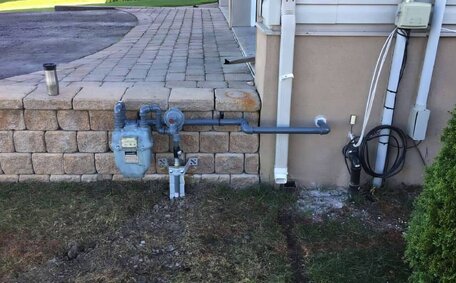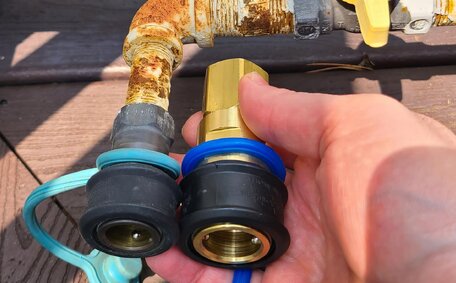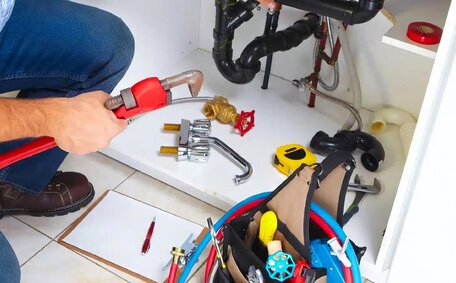What is a Mixing Valve and Why is it Important?
A mixing valve, also known as a tempering valve or thermostatic mixing valve (TMV), is a plumbing component that combines hot and cold water to ensure a safe, consistent output temperature. Mixing valves are critical for creating a secure environment, as they balance hot and cold water to achieve and maintain the desired temperature for safety.
The hot water tempering valve adjusts water temperature to a maximum safe level of 50 degrees Celsius for showers, baths, and sinks.
However, instances where changes in water temperature result in hot water emerging too hot can lead to severe burns without proper thermostatic control that valves can provide.
Without mixing valves, there is a heightened risk of scalding, which these valves mitigate by regulating excessive temperatures.
Someone flushing a toilet or running a tap elsewhere can drastically impact water temperature. A mixing valve excels at managing water temperature, ensuring a stable and secure output by efficiently blending hot and cold water.
It’s crucial to understand that mixing valves are key safety components that safeguard the integrity and safety of water systems.
They are essential for delivering water at a safe and constant temperature across both residential and commercial settings.
Types of Mixing Valves Explained
There are three main types of mixing valves:
- Pressure balancing valves - These ensure a reliable water output temperature by intuitively modulating flow hot cold water to counter shifts in water pressure. Often used for showers.
- Thermostatic mixing valves (TMVs) - Series mixing valves, such as TMVs, blend hot and cold water to achieve a precise, pre-set outlet temperature up to an accuracy of ±1°C. These devices, recognised as valve TMVs within the plumbing industry, implement series mixing via a thermostatic element that expands or contracts to steadily create a temperature mixed output. Widely used to prevent scalding.
- Threeway mixing valves - These tempering valves regulate temperatures by blending a stream of cold water hot with water from a hot water tank or heater. They are more common in situations where cost-effectiveness trumps precision in temperature control.
Essentially, TMVs offer unmatched precision, consistently maintaining accuracy in water temperature.
Pressure balancing valves maintain constant water temperature stability, even with significant pressure variations in your water supply. Water tempering valves offer crucial temperature adjustments, balancing safety with cost-effectiveness.
Each mixing valve type, as recommended by experts, plays a crucial role in adjusting the optimal temperature for safe hot water use in different settings.
When it comes to safe water use, the role of mixing valves in maintaining the balance of temperature amidst hot and cold streams is pivotal.
When is a Mixing Valve Required? Scald Prevention Regulations
Building regulations and plumbing codes mandate mixing valves in certain environments to prevent scalding and to ensure safe water temperature delivery. Key situations where installation of a thermostatic mixing valve (TMV) is required in plumbing drainage systems, ensuring safe water coming out, include:
- Aged care facilities
- Healthcare facilities like hospitals and medical centres
- Childcare centres and kindergartens
- Public facilities with disabled access
These environments cater to individuals at high risk of water-temperature-related injuries.
Australian Standard AS 4032.1 requires that TMVs in early childhood centres temper water to 50°C or lower to protect against child scalds. This demands a fail-safe TMV, required to prevent circumstances that can cause harm, while providing the utmost precision in temperature regulation.
Builders ensure a valve installed caters to factors such as:
- Water heater storage temperature - Systems storing above 60°C where water can require tempering
- Temperature fluctuations - Mixing valves moderate the temperature between two instances like toilet flushing or other water usages.
- Outlet types - Higher risk baths/showers need regulation to 50°C
Ultimately, mixing valves are vital inclusions in many plumbing systems to align with safety regulations and provide scald protection. Their installation should be seriously considered in both commercial and residential settings.
Installing and Maintaining Your Mixing Valves
Expert integration of a mixing valve into your plumbing system is necessary to ensure optimal performance and safety. To make sure a mixing valve is integrated into your home system precisely and to ensure your safety, a tmv licence plumber should be consulted for the setup, considering:
- Selecting appropriate control valves for your application, taking into account factors such as flow rate, pressure variation, and temperature control needs
- Installing the mixing valve in an accessible location for maintenance while minimizing potential temperature variation
- Ensuring correct hot and cold water connections matched to valve inlet markings
- Testing and calibrating to ensure the hot water temperature does not exceed 50°C
Proper maintenance of all mixing valve types is vital for user safety and system durability.
Key procedures can used include:
- Inspection - Check for leaks, corrosion and scale buildup. Ensure outlets don’t exceed 50°C
- Cleaning - Remove inlet filters and flush valve with water. Use descaling solution if required
- Temperature Testing - Confirm outlet temperatures using an accurate digital thermometer
- Adjustments - Re-calibrate thermostatic valves to 50°C if outlet temperatures creep higher
Healthcare and aged care facilities, categorised as high risk, require rigorous maintenance regimes for TMVs and demand thorough attention.
AS 4032.1 outlines that the valve must be serviced semi-annually, involving disassembly, cleaning, and component replacement if needed.
Mixing valves that receive regular maintenance enjoy an extended lifespan and provide ongoing scalding protection.
Check your valve at least annually and consider visiting our customer support for a professional plumber promptly for servicing if any issues arise.
Signs of Mixing Valve Problems and When to Call a Plumber
Issues with mixing valves often become apparent through changes in water temperature. Common signs include:
- Varied temperatures, suggesting flow instability when cold hot water rapidly shift from one extreme to another
- A sudden increase in very hot water that burns or scalds
- Mixer making excessive noise during operation
- Visible water leakage from the mixer body
- Complete failure of hot/cold water mixing
Before calling a plumber, try these basic troubleshooting steps:
- Check inlet filters for blockages and clean if needed
- Inspect the valve for physical damage or loose connections
- Test the outlet temperature using a digital thermometer
If these steps don’t resolve performance issues with the mixing valve, contact a licenced plumber for repairs.
Seek immediate assistance if you experience:
- Total failure of hot or cold water flow
- Inability to adjust water temperature
- Temperatures surpassing 50°C present a considerable risk of scalding
- Significant or worsening leaks
Contact our customer support team at Marsfield Plumbing for high-quality mixing valve repair, installation, and advice.
For expert customer support and assistance with your inquiries, visit our website. Contact us online or call
1300 349 338 to schedule an appointment.
How Do Mixing Valves Ensure Safe Hot Water Temperatures?
Mixing valves regulate the balance between hot and cold temperature outputs from your water heater
using a thermostatic element that reacts to thermal fluctuations. Here’s how it works:
- The valve unites hot water from the water heater and cold water from your water supply, ensuring hot water without risk of scalding, by way of a mixing chamber.
- A thermostatic element within the mixing valve which responsively modulates the temperature of mixed water, expands and contracts ensuring safe hot water coming out with balanced warmth.
- As the hot water becomes too intense, the thermostatic element expands, allowing more cold hot water in so the safer temperature comes out.
- Conversely, if the mixed water drops below the set temperature, the element contracts, reducing the cold water inlet to maintain consistent hot water flows.
This constant adjustment by the thermostatic element maintains the output water temperature as it intelligently blends cold water into hot to maintain the set point - usually 50°C to prevent scalding.
So in summary, thermostatic mixing valves react to temperature changes and continuously moderate the blending of hot and cold water to deliver a consistent, safe outlet temperature.
Common Kitchen and Bathroom Mixing Valve Applications
Mixing valves have several useful applications in kitchens and bathrooms:
- Your shower - Thermostatic mixing valves meticulously regulate the temperature hot water blends with cold, delivering a warmth level that’s comfortable and safe. They blend water hotter than tempering options and cold streams to a consistent and safely managed 50°C.
- Bathtubs - Much like showers, bath mixing valves moderate water temperatures for comfort and safety.
- Basin Taps - Taps supplying basins in kitchens, bathrooms and laundries often have integrated pressure balanced mixing valves to maintain temperatures.
- Dishwashers - Some dishwashers connect to hot water feeds via a mixing valve to safely heat wash water.
In wet areas, precise control over water temperature is crucial for safety and comfort.
Exposed water outlets pose scalding risks if excessively hot. By deftly managing both hot cold streams, mixing valves enable safe, consistent temperatures for all household applications.
Thermostatic valve vs traditional alternatives embody the difference in enhanced settings for more efficient water heating. This prevents Legionella growth while still providing tempered water to fixtures. Integrating mixing valves into your water system refines both thermal comfort and adherence to safety standards, ensuring water is hot and at agreeable temperatures.
Comparing Residential and Commercial Mixing Valve Uses
Mixing valves serve critical roles in managing domestic hot water for both residential and commercial settings, albeit with more stringent requirements in commercial spaces.
In residential settings, mixing valves aid significantly in enhancing your water heating experience by offering:
- Prevent scalding by tempering hot water to bathtubs, showers and sinks
- Allow higher hot water heater temperatures to control Legionella bacteria growth while providing safe outlet temperatures
- Moderate temperature fluctuations from usage across the home
Key differences in commercial facilities include:
- Mandatory installations - Standards like AS 4032.1 require tempering valves in childcare centres, healthcare facilities etc.
- Precise control - Commercial TMVs must regulate to ±1°C to tightly control risk
- Frequent maintenance - 6-12 monthly servicing regimes to maintain performance
- Fail-safe operation - Critical valves often have built-in redundancy to ensure constant tempering
Although mixing valves serve the same fundamental purpose, the implications of failure in commercial environments are far more severe.
As a result, more rigorous standards and fail-safes apply to such installations.
Winterization Considerations for Outdoor Mixing Valves
Outdoor mixing valves on pipes exposed to freezing temperatures need special care to avoid damage.
Proper winterization, to manage water flows even in cold conditions, is crucial depending on climate specifics.
Key steps when preparing an outdoor mixing valve for winter include:
- Applying insulation to exposed hot and cold inlet pipes can also used to inhibit heat dissipation
- Wrapping the mixing valve body in insulating material
- Installing heat trace wiring on inlet pipework that activates below 7°C
- Testing the mixing valve at regular intervals throughout winter
- Checking for and repairing any leaks that allow water to pool in the pipework
Thermostatic mixing valves (TMVs) are particularly vulnerable if water in the valve body freezes and expands. This can split the valve, rendering it unusable.
In the realm of space heating, tempering valves are considered lower risk thanks to their constant water flow, which helps in preventing pipe freezing. But idle pipes still demand insulation and heat tracing.
In colder climates, it’s what you need know - consulting with a plumber about the best mixing valve technology for your application is wise. And be vigilant with winterization to ensure frozen pipework doesn’t put your plumbing system at risk.






